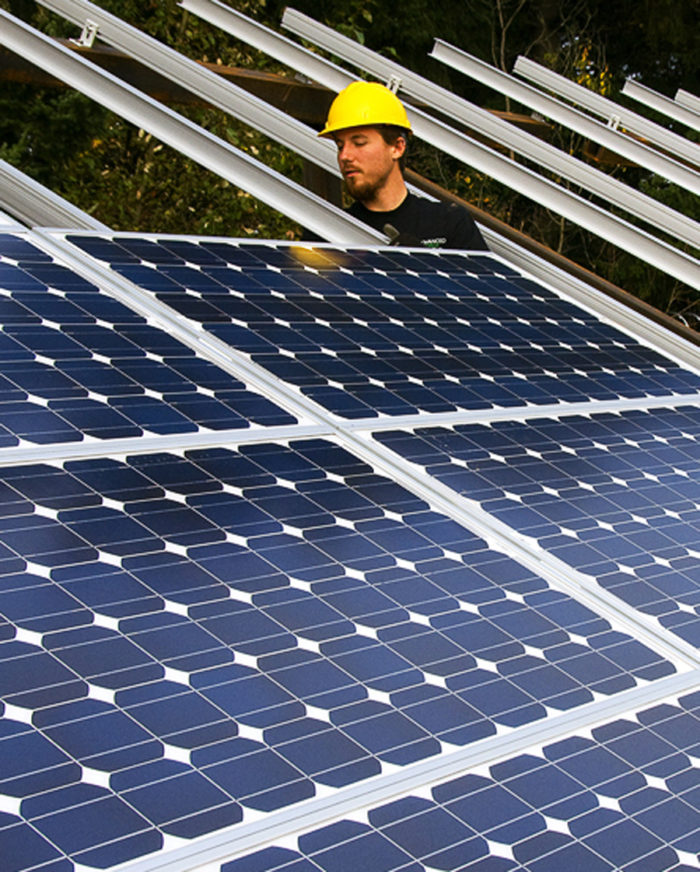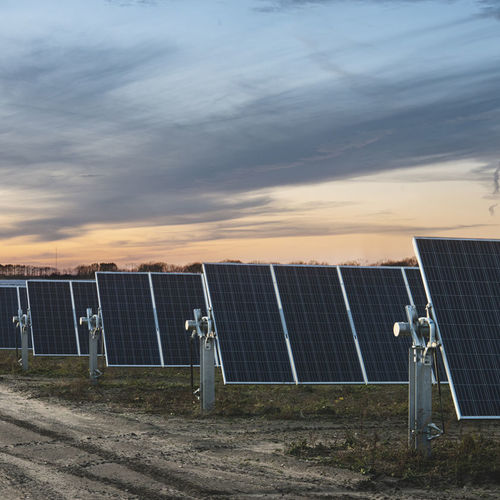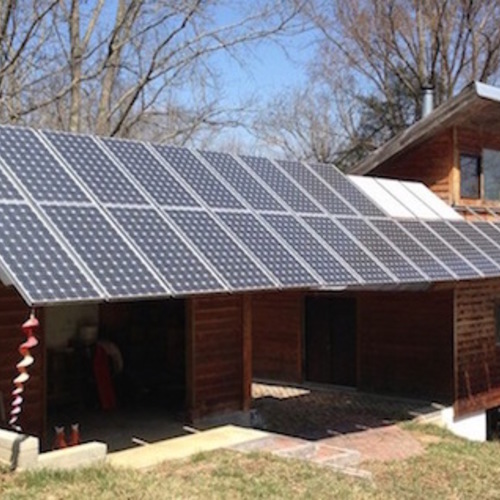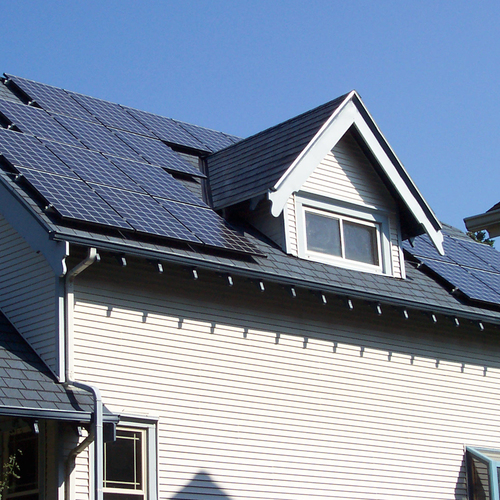
Image Credit: Oregon DOT / CC BY 2.0 / Flickr
The cost of to install a utility-scale photovoltaic (PV) system will reach a key milestone set by the Department of Energy (DOE) by 2020 and fall to below $1 per watt, GTM Research says in a new forecast.
A summary of findings posted by the MIT Technology Review said that crossing the $1-per-watt barrier was an important step because it represents the point at which solar electricity becomes competitive, without subsidies, with the cost of power generated in plants that burn fossil fuels.
Residential PV prices now average about $3 a watt, and commercial prices have dipped to less than $2 per watt. Report author Ben Gallagher said future price declines would be “largely driven by reductions in soft costs” — design, labor, permitting, and overhead — not by reductions in the cost of PV modules themselves. Soft costs account for about 64% of the total, according to the DOE, but GTM thinks they will still make up 60% of total system costs by 2020.
“Soft costs present both the biggest opportunity but also the largest hurdle for future cost reductions, particularly in the residential and commercial market segments where prices are much higher than in the utility-scale segments,” GTM reports. (The bulk of the GTM report is behind a pay wall.)
DOE announced its SunShot Initiative in 2011. Since then, the cost of installing a PV system has dropped by as much as 65% and the number of solar installations in the U.S. has climbed to about 1 million.
But, the MIT report says, there are challenges ahead.
True costs are higher. A price of $1 per watt is how much a utility or developer would pay a construction firm to install a PV array and the necessary inverters. But it doesn’t include a variety of other costs, such as transmission lines to move the power around, energy storage, and software to manage the grid. Andrew Mills of the Lawrence Berkeley National Laboratory says that depending on a variety of factors, a $1-per-watt facility will produce electricity at a cost of about 6 cents per kilowatt-hour. While that’s about the same as a natural gas plant, the need for backup power to supplement the intermittent nature of solar adds about 20% in costs.
Solar is still small. Even after crossing the 1 million mark for installations, solar power accounts for just over 1% of the total electricity production in the U.S. and will “barely” reach double digits by 2020 even with robust growth rates in utility-scale projects. The U.S. Energy Information Administration (EIA) says that all forms of renewable generation will total 15.6% of the U.S. total by 2020, with coal and natural gas making up 65% of the total — even with solar at $1 per watt. (However, the EIA’s track record on renewable energy predictions has been criticized in the past.)
The pace of growth will slow down. Frank O’Sullivan, director of research and analysis for the MIT Energy Initiative, says that strong growth in solar will drive down the price of electricity from all sources, which will in turn dampen growth. “Beyond a certain point, new solar installations start driving down the price of power not only from solar plants, but also from the always-on fossil-fuel plants that supplement intermittent solar power,” the MIT report says. “That’s a good thing if you’re a customer buying cheap power. It’s not so good if you’re a power plant operator and need a return on your investment. If big solar power additions make it harder for owners of power plants to recoup their costs, that means that growth in the solar market is to some extent self-limiting.”
Too much can be a problem. Finally, MIT Technology Review says, it’s possible to have too much solar on the grid, as has been the case at times in Germany, California, and Texas. Spot prices for electricity can dip below zero, meaning that utilities have been forced to pay grid operators to take electricity off their hands. Cost-effective energy storage and better ways of balancing supply and demand across the grid will be needed.
Weekly Newsletter
Get building science and energy efficiency advice, plus special offers, in your inbox.















5 Comments
residential PV price correction
"Residential PV prices in the U.S. average $3.00 as of the first half of this year. According to the report, soft costs make up 64 percent of residential system costs today, and despite system prices falling by a third by 2020, soft costs will still account for 60 percent of the total system price."That is a quote from GTM report.
A mistake in this article says "Residential PV costs should drop to $3 a watt". They are already there. They will drop a further 33% to $2 watt by 2020 according to the report. The DOE sunshot goal for residential is $1.50 watt, and I expect if Australia can do that now, the U.S. should manage that in 4 years.
Price correction
Thanks, Ven. The post has been edited to reflect the fact that residential prices already average $3 per watt.
...just over 1% of the total electricity production in the U.S.
... and will "barely" reach double digits by 2020 ..."
That is phrase as if it's nearly nothing, but anything that is slated to grow 10 fold in under four years is a veritable tsunami.
The time of day that the PV is producing is very relevant for peeling off air conditioning peak grid loads, and if it's 10% of all power on average, it is going to be a very large fraction of the mid-day load. That's the "...too much solar on the grid..." scenario that drives the LMP below zero. But again the phrasing belies a bias in the point of view: It's only "too much" when the other generators on the grid are too inflexible to accommodate. The large thermal coal and nuclear generators severe ramp-rate limitations are the generators paying when the LMP goes negative. That's a problem for them (and possibly their business model), but it's not necessarily a problem for the ratepayers.
Storage is often assumed to be the solution, but putting all of that cost onto the cost of PV column would be a mistake- some fraction is rightly apportioned to the inflexible power generators. But the amount of storage needed to stablize things isn't nearly as big as simple napkin math models might indicate (smarter loads under utility control or real-time LMP pricing to allow it to be under ratepayer control would both be cheaper solutions.
The nearly silent but growing elephant calf in the room is how the electric vehicles and smart charging systems will be able to take advantage of the availabity of cheap mid-day power when PV goes well into double-digit percentages of all kwh shipped onto the grid.
Negative pricing isn't only a solar thing. It happens fairly often in the not-so-sunny ISO New England region, typically in the overnight hours when the grid load drops way below the daytime load in the summer, when a lot of less flexible generation was ramped up to be able to take advantage of the higher peak pricing from the evening prior. If you look quickly at today's LMP history, you'll see two spikes down to the -$38-40/Mwh range, one at about 3:30 AM and another at about 6.05AM, as well as a half hour of -$5/Mwh between 4:30 and 5:00 AM:
http://www.iso-ne.com/isoexpress/web/charts
http://www.iso-ne.com/isoexpress/web/charts/guest-hub?p_p_id=fiveminuterealtimelmp_WAR_isoneportlet_INSTANCE_a3zQ&p_p_lifecycle=0&p_p_state=pop_up&p_p_mode=view&p_p_col_id=column-2&p_p_col_pos=1&p_p_col_count=3
With a lot of wind or solar on the grid those events will eventually happen at other times as well, but again, it's only "too much" intermittent renewables when the rest of the generating capacity lacks flexibility.
By June 2018 there will be active demand response programs in the ISO-New England system that will ease much of this "problem" by applying dispatchable non time critical load when there is a surplus of power, and shedding load when the generating or transmission capacities are near the limits. Similar programs are already operating in several parts of the US.
What's the problem with unused generating capacity?
This is probably a dumb question from a newby, but can you give me a high-level explanation of "it's possible to have too much solar on the grid"
If I had a solar panel on my roof, and I wasn't using any power, would that create a problem?
Is the issue simply that there are not enough electricity users willing to pay for the available generating capacity at certain times of the day?
Why do utilities have to pay grid operators to take electricity off their hands? If no one is using the power, can it not just sit there unused? Kind of like my generator idling until I put a load on it?
Response to Mike Strevell
Mike,
As far as I know, PV modules aren't harmed if they aren't connected to a load when the sun is shining.
The problem has nothing to do with damage to the PV modules; it has to do with grid management. The power produced by the PV systems connected to the grid is being conveyed by the cables strung by the local utility, and too much PV power might result in an over-voltage situation or problems arising from too much current flow if the proper grid controls aren't installed.
Log in or create an account to post a comment.
Sign up Log in